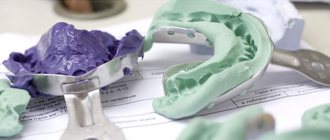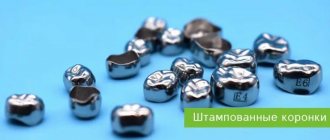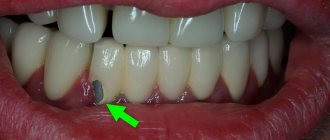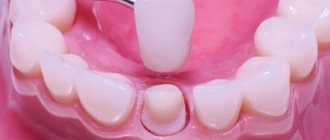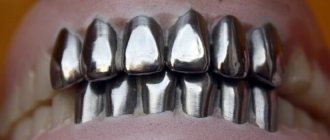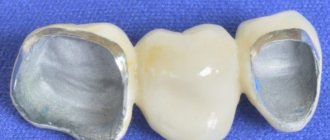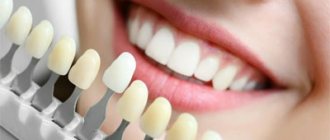Fixed prosthetics is a popular method of restoring the appearance and chewing-aesthetic function of the dentition. Reconstruction of damaged teeth with artificial prostheses covering only the supragingival part of the tooth is performed with metal, metal-ceramic, all-ceramic, metal-plastic and other crowns. Metal-ceramics are most in demand because... in terms of external data and technical characteristics, it is not much inferior to metal-free ceramics.
A metal-ceramic prosthesis consists of a frame based on a cobalt-chromium alloy, titanium, galvanic gold, platinum or palladium, coated on top with a ceramic mass. Based on the quality of ceramics, crowns are divided into standard and highly artistic.
Differences from metal and all-ceramic
A metal-ceramic (MC) crown is the best option for covering the destroyed coronal part of a tooth, because with its help, size, shape, color and chewing function are restored. However, the tooth must first be treated with endodontic methods.
All-ceramic products are distinguished by their artistry, less thickness because they lack a metal frame, but also greater fragility. In this regard, metal-free crowns are placed mainly on the frontal areas, although they are also allowed on premolars, because they don't have to bear a lot of stress when chewing. In addition to ceramics, porcelain crowns based on zirconium dioxide are used in their pure form. This is a white translucent metal that serves as a substrate for applying ceramic mass. The small thickness of the prosthesis allows the use of a minimally aggressive technique for preparing vital teeth.
Metal crowns are made by casting or stamping from gold, silver-palladium compounds, cobalt-chromium and nickel-chromium alloys. These thin-walled copings are designed to strengthen the coronal portion. Their appearance is unpretentious, so they cover only the chewing group of teeth. Prostheses made of base metals are available without sputtering (“silver-like”) and with sputtering (“gold-like”). Products made from electroplated gold are convenient in cases where the patient has a history of allergies to metals.
Operation
Medium difficulty
There are contraindications
Doctor's qualifications
High
Is there an alternative to metal ceramics?
It is not difficult to replace metal-ceramic crowns; the most difficult thing will be the choice between the desire for a beautiful smile and the desire to save money. When making a decision, consider where exactly in the dentition the organs that require restoration are located:
- Frontal teeth. Here it is better to prefer aesthetics and opt for metal-free prostheses made of zirconium dioxide or porcelain crowns. In addition, the chewing load on these teeth is minimal. And in any case, you will have to say goodbye to the bad habits of biting threads and gnawing seeds.
- Chewing teeth . Functionality and reliability are more important here. You can install an all-metal crown, which will give odds to even metal-ceramics in terms of strength, durability and gentle pre-treatment of the tooth before prosthetics. The main thing is to make sure that such a crown will not shine from the depths of the mouth when talking and smiling, because this is unacceptable, for example, for public people or those occupying high positions.
- Combination of teeth . Let's say a patient needs to install a bridge between the fourth and sixth teeth. The number four is exposed when you smile, and this tooth attachment is made of metal ceramics, while the other units are solid cast metal. In addition, less teeth are prepared for metal structures, which means the bridge will last longer. Let’s assume an option that combines metal-free and metal-ceramic units. This will reduce the cost of the design without compromising the aesthetics.
Metal-ceramic crowns - photo
The photo shows the following types of metal-ceramic crowns:
- For side sections;
- Frontal crown;
- On a frame made of irradiated gold;
- MK with pin;
- Telescopic;
- Half-crown.
Photo of dental crowns
How often do you visit the dentist?
Are you using metal ceramics? Do you know the properties of this material?
Often, when talking about metal-ceramics, they mean an orthopedic structure, the manufacture of which uses the following methods: spraying or ceramic casting on a metal frame. In general, these are metal-ceramic crowns and bridges. Simply, dental metal-ceramics consists of a metal base that recreates the shape of the tooth, which is prepared and covered with a thin ceramic layer on top.
Metal ceramics, used in dentistry, is a material that is hypoallergenic and compatible. It is almost never rejected by the human body; exceptions are very rare, often due to allergies. Primarily, in orthopedics, metal-ceramics are used when it is necessary to replace chewing teeth, for which functionality is important and only then aesthetics.
Advantages of metal-ceramic crowns
There are many advantages of metal-ceramic dentures:
- The color, shape, size, transparency and strength of the artificial prosthesis are identical to the patient’s own teeth;
- Strengthening and reinforcing the crown part gives the tooth a “second” life for many years;
- Metal ceramics do not change color and soft and hard deposits do not accumulate on it;
- The degree of abrasion of ceramics is close to that of enamel;
- Due to the exact correspondence of the shape and size of the metal frame to the contours of the stump, the crowns “sit” firmly and do not allow microorganisms to pass under them;
- The metal base gives the crown increased strength, so “protected” teeth can withstand high mechanical loads;
Cost of the operation
from 20,000 rub.
Recovery time
from 3 days
Operation time
from 60 to 180 minutes
Which teeth are better: metal-ceramic or ceramic?
When a person decides to use the services of a dentist for dental prosthetics using crowns or bridges, then he will definitely be faced with the question of choosing, metal-ceramics or ceramics, which is better to use? What is the difference between the aesthetic and functional characteristics of these materials?
If we talk about metal-ceramic structures, it should be mentioned that they are very durable, but they have drawbacks regarding aesthetic appearance. This can be unpleasant when they are used for prosthetics in the smile area. If it is necessary to install the front teeth, then the orthopedic material should be selected from solid ceramics. To restore chewing teeth, of course, it is possible and necessary to use metal-ceramic material, because here aesthetics will not play such a big role. And it should be understood that ceramic prostheses are often too expensive.
Flaws
The disadvantages of metal-ceramics are mainly due to the thickness of the prosthesis. The metal frame and ceramic layer force the dentist to sharply grind the tooth. Therefore, dental units subject to prosthetics are first subjected to endodontic treatment. This is undesirable for a healthy tooth, since depulpation makes it more fragile.
Dental prosthetics with products is not recommended for children under 16 years of age due to the thin enamel-dentin layer and the close proximity of the horns of the pulp chamber, which means depulpation will inevitably be required.
The ceramic mass completely covers the metal base, with the exception of a small gap on the lingual side. The open metal part (“garland”) can cause discomfort in the oral cavity, and in cases where the patient already has other metal dentures, galvanization phenomena are possible.
In the frontal area, products made from MC may not look very natural, so here it is advisable to do prosthetics with all-ceramic crowns.
How is a crown made?
Many patients wonder how long it takes to have metal-ceramic dental prosthetics. It is important to understand here that the procedures for preparing the teeth and the installation itself are carried out quite quickly, but the manufacture of the structure takes longer. As a rule, 1-2 weeks are enough to make a metal-ceramic crown. Based on the casts created, specialists make a plaster model - it is cast according to the impression after a preliminary assessment of its quality.
Then a dental laboratory specialist models a framework for metal-ceramics using wax. The finished frame is fixed on a plaster model and sent to an orthopedic doctor so that he can try it on in the patient’s mouth.
Then ceramic mass is applied to the frame. Before this is done, it is fired in a kiln and sandblasted - this allows for better adhesion of the metal and the ceramic mass.
The opaque is applied first - this is an opaque composition, then the structure is covered with a dentin layer (more transparent), and then with an enamel layer. This technology makes it possible to recreate the natural appearance of a tooth, taking into account the individual characteristics of the color of the enamel of your own teeth.
After the patient has tried on the design, glazing and final firing are carried out - then the crown is installed.
Types of metal-ceramic crowns
The main task of a MC prosthesis is to protect and strengthen the heavily damaged crown part of the tooth. Such crowns completely envelop the tooth on all sides.
There are crowns with a pin that serve both to restore the integrity of the tooth and to strengthen it. They are used for very badly damaged coronal parts. The pin is cemented into one of the roots of the tooth.
A half-crown is a prosthesis covered with ceramic mass only on the oral and chewing sides (or on the cutting edge side), as well as on the sides in contact with neighboring teeth. The lingual side of the prosthesis remains uncovered. Typically, such measures are resorted to to reduce the cost of the crown.
Telescopic crowns have an internal built-in lock designed for fixation to the stump inlay on the abutment tooth of a removable denture.
Based on the manufacturing method, a distinction is made between MC prostheses that have undergone sintering or those made by computer modeling and milling.
Which dentistry in Zvenigorod is best to choose for prosthetic crowns?
There are many dental clinics in Zvenigorod.
One of them is the dental department of the Istok Health Clinic. The dental clinic has been operating in Zvenigorod since 1992. There are 7 dental offices equipped with the most modern equipment, its own dental laboratory, X-ray room, and sterilization department. Here you can receive a full range of dental services, and you can get an appointment at virtually any convenient time. The Clinic's management closely monitors the quality of services provided and materials used.
Indications for installation
Basically, metal-ceramic prostheses are placed in the following cases:
- destruction or traumatic fracture of at least 2/3 of the crown part of the front or chewing teeth;
- extensive fillings that spoil the aesthetics or do not adhere well to the teeth;
- anomalies in the shape, size, color or position of individual dental units that cannot be corrected by other dental methods;
- pathological abrasion of enamel;
- non-carious lesions of enamel, fluorosis;
- age-related changes in the shape, color, shine of individual teeth or disruption of their aesthetics after previous dental treatment;
- allergic reactions to crowns made of other materials;
- moderately loose teeth. In this case, prostheses are used for splinting, but they are not put on individual units, but in the form of a small metal-ceramic bridge;
- preparing an abutment tooth for attaching a clasp to attachments or a denture to telescopic crowns.
Prosthetics
Metal-ceramic dental prosthetics can be used both in the frontal area of the smile and in the lateral areas.
Prosthetics of anterior teeth
It is possible to place metal-ceramics on the front teeth, but from an aesthetic point of view, such a solution would not be the best option. The fact is that in the frontal zone the transparency of the tooth enamel is greater than in the lateral zone, so the metal frame can be seen through the ceramic coating. Therefore, for prosthetics in the smile area, as a rule, solid ceramics or ceramics on a zirconium frame are used. However, if the patient wishes, metal-ceramics can still be installed on the front teeth. Moreover, if dentures are carefully and regularly cared for, their service life on the front teeth, according to patient reviews, can be more than 10 years.
Prosthetics of chewing teeth
The most popular are metal-ceramics for chewing teeth in the lateral regions, where strength is more important than appearance. However, it cannot be said that such crowns or bridges on chewing teeth look unaesthetic. These dentures closely imitate the structure and shades of natural dental tissue. But their main advantage is still their ability to withstand any chewing load.
Contraindications
Metal-ceramic crowns are not used for prosthetics in the following situations or conditions:
- destroyed crown part of the tooth in children under 16 years of age;
- low or flat coronal part with a thin layer of enamel-dentin layer and proximity to the pulp chamber;
- advanced periodontal disease;
- deep crossbite;
- parafunction of masticatory muscles and bruxism;
- pathological mobility of teeth 3 degrees;
- chronic periapical inflammation.
Metal-ceramics or metal-plastic – what to choose?
You need to understand that metal-plastic crowns are not designed for long-term use; they are a temporary solution. By choosing metal-ceramic dental prosthetics, the patient receives the optimal price-quality ratio. These prostheses have a lot of advantages, and the cost is more than justified.
A doctor from our clinic will help you finally decide on the type of prosthesis. He will conduct a thorough examination and recommend the most suitable prosthesis for your case. He will also carry out the installation professionally. Modern equipment and the use of advanced prosthetic techniques, multiplied by many years of practical experience of our specialists, ensure painlessness throughout the entire process. We provide a guarantee for the installed prosthesis because we are confident in the high quality of work.
Stages of crown installation
Before starting to manufacture and fix the crown, the doctor conducts an examination and hardware diagnostics of the oral cavity, eliminates pockets of caries, and replaces old restorations on the problem tooth. Next, endodontic treatment is carried out. Only after this they begin to prepare and form a conical stump with a ledge. If the causative tooth fits into the smile line, it is covered with a provisional crown.
At the next stage, an impression of the teeth is taken, which is sent to the dental laboratory. Using it, the technician makes a working model from plaster and casts a metal frame (cap) that exactly follows the contours of the tooth stump. The cap is given to the dental clinic for fitting in the patient’s mouth. During the same visit, the color of the porcelain veneer is selected, and the cap is returned to the technician. He applies several layers of ceramic mass and fires the product in a kiln.
The almost finished MC crown is tried on the tooth. The doctor indicates the necessary changes on the accompanying sheet. The technician makes adjustments and begins glazing the denture to give it the shine and refractive structure of natural teeth. To make the dental prosthesis look like adjacent teeth, before glazing, the technician applies small spots or imitates cracks with a brush. This is especially true for crowns on front teeth.
At the last visit, the crown is tried on again, and if no errors were found, it is cemented.
Pros and cons of metal ceramics
Many patients who decide to undergo prosthetics are concerned with the question: “Are metal-ceramics harmful?” If all manufacturing and installation standards are observed, harm is minimized and practically eliminated. Modern materials do not contain any toxins. However, it is worth remembering that different types of materials may behave differently in the oral cavity. Thus, in the case of chromium-nickel alloys in the crown frame, allergies to nickel are common, and some base metals can oxidize over time under the influence of saliva. Among the advantages of metal-ceramics are high strength and long service life, and the disadvantages are the possibility of exposing the metal frame when the gums recede (the exception will be crowns made of zirconium dioxide), the translucency of the frame through the ceramics and the need for rather strong grinding of living tooth tissues under the crown, up to depulpation of the living tooth tooth without direct evidence.
Strength
Currently, metal-ceramic dentures, both single and bridge-like, are in most cases used on teeth that have a significant chewing load. Although until recently they were the undoubted leader, regardless of what types of dental prosthetics were used. Ceramic crowns, on the contrary, were not popular for a long time due to the increased fragility of the structure and therefore were used only for prosthetics of the frontal group of teeth. However, with the advent of frameworks made of zirconium dioxide or aluminum dioxide, more and more dentists and patients prefer these modern materials for prosthetics of both chewing and, in some cases, anterior teeth.
It is worth noting that the excellent strength of metal-ceramic prosthetics can negatively affect the surface of the teeth intersecting with them and lead to their excessive abrasion. At the same time, metal-free dentures have a hardness coefficient close to that of natural teeth, which makes it possible not to injure opposing teeth.
Allergy
The ceramics used to make crowns are absolutely hypoallergenic, but the metals used in the frame can in rare cases cause an allergic reaction. Symptoms of an allergy to metal ceramics are a burning sensation in the mouth, in the area of both the gums and the tongue, a metal bite, swelling of the gums in the area of contact with the crown and swelling. If the phenomena described above are observed after installing a crown, you should consult a doctor. In such cases, it is recommended to replace the metal-ceramic with an all-ceramic crown.
Life time
One of the saddest misconceptions of patients is that a metal-ceramic crown does not require replacement and will last the rest of its life. Unfortunately, this is not the case and its service life is limited. On average, a metal-ceramic denture can last 10–12 years if the frame is made of an alloy of base metals, and 15 years or more if a gold-platinum alloy is used. However, it is worth considering that the prosthesis must be made strictly according to individual casts, and the patient, when wearing such a fixed or partially removable structure, must follow all care recommendations. The warranty on metal-ceramics lasts on average from one to three years, depending on the material used to make the frame. At the same time, the warranty conditions imply that the crown will maintain its integrity and will not be destroyed by mechanical stress within a specified period, while the most common cause of crown loss is secondary caries that develops at the junction of the tooth and the crown. In order to avoid such situations, it is necessary to regularly undergo preventive examinations and promptly replace old orthopedic structures with new ones. Remember: the denture has a service life, failure to comply with which can lead to tooth loss.
Color
The ceramics used to make metal-ceramic crowns allows you to imitate the color and structure of natural enamel, making the prosthetic tooth as similar as possible to the patient’s neighboring, natural teeth. The color is selected according to the Vita scale, it does not fade or change over time, since, unlike natural enamel and composite materials (for example, fillings), ceramics do not absorb colorants from food and drinks, so bleaching is not required. If you think it’s time to whiten the metal ceramics installed in your mouth, most likely you need to visit a hygienist to remove stained plaque.
Metal ceramics or ceramics?
If you decide to resort to dental prosthetics using crowns or bridges, then sooner or later you will face the question: “Which is better - ceramics or metal-ceramics?” They differ in their aesthetic and functional properties. Metal-ceramic dentures are more durable, but have significant aesthetic disadvantages, which play a big role in restoring teeth in the smile area. Therefore, for prosthetics of the anterior dentition, orthopedic structures made of solid ceramics will be the preferred option. However, it is worth considering that most ceramic dentures are very expensive. In the case when chewing teeth are restored, metal ceramics are quite acceptable, since its aesthetic defects are invisible in the lateral sections.
Metal-plastic
Modern dentistry offers many different options for making crowns, the main difference being the materials used to make the frame and the anatomical shape of the tooth. Some materials are more expensive, others are cheaper, but the quality of crowns, as you might guess, directly depends on the price, since the most durable and aesthetic designs are made from more expensive materials. To the question: “Which is better – metal-ceramics or metal-plastic?” The answer is clear, of course, metal ceramics. Despite the fact that modern dental plastic is of decent quality and hypoallergenic and, just like ceramics, is able to imitate the natural color of teeth, it still loses in many respects, so the choice - metal-plastic or metal-ceramic - is decided in favor of the latter. Plastic is inferior to ceramics both in strength and in its ability to imitate natural enamel. Therefore, plastic in modern dentistry is used exclusively for the manufacture of temporary crowns, those that the patient wears while permanent structures are made in the dental laboratory or while the implant is healing. Making permanent crowns from plastic, and even on a metal frame, is absolutely unprofitable, the service life of metal and plastic is different, and their connection is not justified.
...or metal?
Also today, all-metal crowns are available to patients, but this is the most unaesthetic type of orthopedic structures, which, unlike metal-ceramics and ceramics, are in principle unable to imitate a natural tooth in anything other than anatomical shape. However, metal crowns are noticeably cheaper than metal-ceramics, but inferior to it in most respects. In addition, metal structures can cause increased wear of the teeth with which they come into contact.
Metal ceramics or zirconium?
We have already discussed above how metal-ceramics differs from ceramic-coated zirconium. If you are faced with a choice: zirconium dioxide or metal-ceramics, then in the case of prosthetics of the front teeth, the advantage, of course, is on the side of ceramic crowns on a zirconium frame. As for the teeth in the chewing zone, it is not so important; they are not inferior to each other in strength, and the aesthetic side in the lateral section is not as important as the functional one.
Metal-ceramic crowns - cost of installation
The cost of a metal-ceramic prosthesis includes the work of the doctor and technician, preparation of the tooth for prosthetics and the type of crown. So, if the crown frame is made of gold-containing alloys, then this will increase the total amount by one and a half times (approximately it costs 15-18 thousand rubles). If nickel-chromium or cobalt-chromium alloys are used as a frame, a single crown will cost from 6,500 rubles. Crowns for implants are more expensive, their price ranges from 18,000-20,000 rubles per unit. Highly artistic MKs for the front areas of the jaw will take about 11 thousand rubles from your budget.
Please note that tooth preparation before prosthetics (treatment of caries, pulp removal, replacement of old fillings) is paid separately.
Main features of metal-ceramic prostheses
This type of prosthesis is a type of solid cast structure; it consists of a metal base (frame) with ceramic lining. It is created from special alloys (zirconium dioxide, cobalt/chrome or nickel/chrome) designed specifically for dental needs. Sometimes alloys containing precious metals (gold, silver, palladium) are used to make the base. Depending on what metals the metal ceramics contain, the price of prostheses may vary.
Features of care and service life
The average service life of a crown made from MC is 10-15 years, and with proper individual oral care and regular visits to the dentist for professional hygiene, they can last up to 25 years.
Oral care after prosthetics is no different from what the patient is used to. Brushing your teeth twice a day, rinsing your mouth after eating, using additional hygiene products and devices - dental floss, rinses, brushes, irrigator.
To get a consultation
Metal-ceramic color palette
Photo: color of metal-ceramics
Many people worry that metal-ceramic crowns will have a different shade than their natural teeth and it will look somewhat unaesthetic. But ceramics, which is used in dental prosthetics, makes it possible to imitate not only the color, but also the structure of natural enamel, which will make such a tooth extremely similar to its neighbors. The color palette of metal ceramics has its own Vita scale, under which it is selected. The color of such a prosthesis does not change over time and does not begin to fade, unlike the same natural enamel, as well as composite material (for example, fillings). Ceramic does not absorb dyes that may come from eating or drinking, so you will not need whitening services. When you feel that the metal ceramics located in the oral cavity need to be whitened, then you just need to go to an appointment with a hygienist who will remove plaque.
